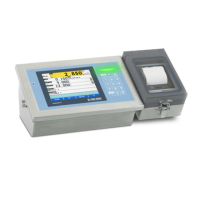5
3590ET / 3590EGT
TECH_MAN_SCHEMES_3590_ENG_vX_17.06
• Mains power supply adjusted within ± 10% of the nominal voltage
• Electrical protections (fuses, etc.) are to be provided by the installer.
• Comply with the minimum recommended distances between different categories of cables.
• The load cell or signal amplifier extension cables, which are used for serial port and analog output connection, must com-
ply with the maximum permitted lengths.
• The load cell or signal amplifier extension cables, which are used for serial port and analog output connection, must be
shielded and must also be inserted alone into the conduit or metal pipe.
• Cell or amplifier cable input into the electrical panel must be autonomous. If possible, they must be connected directly to
the indicator’s terminal board without passing through the conduit with other cables.
• Install an “RC” filter on coil contactors, solenoid valves and all devices that generate electrical interferences.
• If condensation can develop inside the scale’s transmitter, it is recommended to keep the equipment running.
• With regard to all shielded and non-shielded cables (cell cable, PC cable, power supply cable, etc.) that are connected to
the indicator, you must keep the cable as short as possible and make a minimum amount of the cables exit from the shield
in order to be connected to the terminal board;
• If the indicator is situated inside an electrical panel, you must also use a shielded cable for power supply and must keep
the cable as short as possible and far from the cables supplying coils, inverter, electromotive force, etc., and apply a
de-coupling transformer to supply the indicator only.
The various cables are classified according to the signals they transmit:
Category I
• Fieldbus , LAN network ( PROFIBUS, Ethernet, Devicenet...)
• Data shielded cables (RS232 ...)
• Shielded cables for analog digital signals < 25V (sensors, load cells.)
• Low-voltage power supply cables (<60V)
• Coaxial cables
Category II
• DC power supply cables with >60V and <400V
• AC power supply cables with >25V and <400
Category III
• Power supply cables with >400V
• Telephone cable
Category IV
• Any cables subject to lightning hazards
Electrical precautions
Cable classification
Electrical warnings

